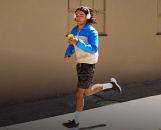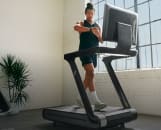
shapecharge / E+ via Getty Images
How to Gauge Your Rate of Perceived Exertion (RPE), According to Fitness Pros
The RPE scale can help you gauge just how hard you’re working during exercise.
By Jennifer Heimlich•
What Is Rate of Perceived Exertion (RPE)?
The Different RPE Scales
Benefits of Using RPE
How to Calculate RPE
How to Use RPE Scales
When to Use RPE
Are There Any Drawbacks of Using RPE?
The Takeaway
You’re on a run, jogging at a comfortable pace and wondering if you should keep cruising or amp up to a faster speed. As it turns out, this internal effort gauge has a name: rate of perceived exertion. But what does it involve, exactly?
Well, rate of perceived exertion, or RPE, is a strategy that can be used during workouts to monitor and fine-tune your intensity. “It’s a great tool to help athletes stay connected to how their bodies are responding to training load or intensities,” says Peloton instructor Ben Alldis, who adds that he often uses RPE in his own workouts. If you want to use RPE effectively to level up your training too, here’s what you need to know.
What Is Rate of Perceived Exertion (RPE)?
In fitness, the rate of perceived exertion is a subjective, internal measurement of your effort level. It’s your own perception, rather than an objective marker like your heart rate, pace, or power output. It was developed in the 1960s by a Swedish researcher named Gunnar Borg who investigated the sensations evoked by exercise.
The RPE scale was originally designed to correlate subjects’ heart rates with their subjective scores without actually seeing the heart rate, according to Daniel Hague, a performance physical therapist at MedStar Health. He points out that wearable heart rate monitors weren’t exactly widely available outside of research labs at that time, so it was helpful to have another way to judge how hard a workout was.
The Different RPE Scales
There are a couple of different ways you can measure RPE, depending on what setting you’re in and what feels most intuitive.
The Borg Scale
One measurement of RPE is the Borg scale, which (as you might have guessed) is named after the researcher who invented it. It rates exertion on a scale of 6–20.
That seemingly random set of numbers makes more sense when you remember it was designed to correlate with heart rate, says Jacob Goodin, PhD, a professor of kinesiology at Point Loma Nazarene University. “You just throw a zero onto the end: Let’s say you rate something at a 20—well, you’re probably somewhere around your peak heart rate, which for most people on average is going to be around 200 beats per minute.” (Of course, this is a broad estimation—the exact numbers will look a little different from person to person.)
The Modified RPE Scale
For the average person, being told to rate your effort on a scale of six to 20 when you’re already busy panting and sweating can feel like suddenly trying to do calculus. That’s why, today, many people use the “modified scale” that rates effort from 0–10, with 5 being moderate effort and 10 being your all-out-max. “That’s not correlated with heart rate,” Hague says. “It’s just a subjective measure of what an individual perceives their level of effort is.”
For instance, here’s what the modified RPE scale might look like if you use a running-based workout as an example:
0: Lying down with no exertion
1: Easy walking
2: Brisk walking
3: Light jogging
4–5: Moderate running
6–7: Vigorous running (think tempo runs or threshold runs)
8–9: Exceptionally hard running (think VO2 max intervals)
10: All-out sprint
Which RPE Scale Should You Use?
Ben says that the modified RPE scale is much easier for most of us to use in general fitness settings since we’re more used to thinking of ratings from 0–10 rather than 6–20. “It is more intuitive for athletes of all abilities,” he says.
These days, the Borg scale is mainly reserved for special scenarios, like when scientists are monitoring athletes in clinical settings. “Really, research is where we use 6–20,” Goodin says. “For almost everything else, I would recommend the 0–10 scale.”

jacoblund / iStock / Getty Images Plus via Getty Images
Benefits of Using RPE
Working out based on your rate of perceived exertion can have a number of benefits.
It Can Help You Manage Energy Levels
Ben points out that RPE can work across modalities—from strength training to cardio workouts like cycling and rowing—to help you regulate how much energy you’re putting into a given exercise. This can help prevent you from injuring yourself or simply burning out during a workout by going too hard too fast.
Hague adds that RPE can especially come in handy when you’re dealing with cumulative fatigue if multiple workouts—and regular ol’ life—are making you more tired than usual.
It Acts as a Personal Progress Indicator
RPE can also be a way to track your progress over time. For instance, if cycling your typical 20-mile route in an hour felt like a level-7 effort last month but now feels more like a 5 or 6, that’s a sign of improving fitness.
It Sharpens Your Mental Training
There are also mental benefits of considering your rate of perceived exertion, Goodin says. In particular, regularly thinking about our RPE can change our relationship to fatigue and discomfort as athletes.
“That’s a really unique thing about RPE—the reflective process of getting used to and comfortable with the discomfort of training,” he says. “You start to get to the point in your race where these negative signals from your brain say, ‘Hey, you need to stop,’ and you interpret that as, ‘Oh, I’m doing exactly what I need to be doing because this is a 10 out of 10.’” Over time, you learn not to back off when you feel that satisfying muscle burn, but rather (when appropriate), to lean into it as a sign that you’re doing precisely what you’re supposed to.
Of course, this distinction can take some getting used to. Always stop if you experience pain, injury, intense fatigue, extremely negative thoughts, or other red flags.
How to Calculate RPE
Putting an exact number on your effort level can feel a little tricky, particularly if you’ve never done it before.
Goodin suggests starting by doing a maximum-effort test. “If it’s in the weight room, go do a 1 rep max or a 5 rep max where you actually go until you fail a set,” he says, adding that, of course, you’ll want to do this with a spotter to be safe. This will help you find what a 10 out of 10 feels like, then you can work backwards from there. For cardio workouts like running, you can do a race or time trial. “Whatever you felt near the end of that race or time trial, that was your 10 out of 10,” he says. “Do that, and then you can scale everything back accordingly from there.”
Once you’ve done that max-effort test, regularly check in with yourself about your effort level during workouts. “Think, ‘What is this? Is this an 8? Is this an 8.5?’” Goodin says. “What it forces you to do is to reflect on those internal processes, your perception of fatigue.”
To figure out what number makes sense, Ben recommends paying attention to cues like how fast your heart is beating, how hard you’re breathing, the amount of muscle fatigue or burn you’re feeling, whether your form or posture is breaking down, and what the mental effort feels like.
However, know that calibrating your energy this way requires patience. Hague warns that it can take awhile to get a feel for your personal efforts that relate to different numbers on the scale. “In large part at the beginning, it’s just practicing it, creating set references for yourself,” he says.

Lu ShaoJi / Moment via Getty Images
How to Use RPE Scales
Once you’ve figured out how to put a number on your effort level, you can use RPE to get a subjective measurement of how hard you’re working out, Hague says. You can do this either mid-session to gauge your effort moment-by-moment in real time or post-workout to reflect on how it went.
To use RPE during your workout, do a mental “systems check”—reviewing how hard you’re breathing, how quickly your heart is pumping, how intense the muscle burn feels, and so on—then adjust your effort level up or down if needed to make sure you’re matching the intent of your training session. “Do I feel really tired? Am I able to push [into a higher heart rate zone] right now, or do I feel like if I do that, I’m going to crash and burn too early?” Hague recommends asking yourself.
You can also rate how hard you pushed yourself overall after a training session. Hague recommends doing this as soon as you finish while it’s still fresh. Keeping a fitness journal is a great way to record these ratings; that way, you’ll be able to look back on your workouts and accurately compare how much effort you put in. Goodin adds that if you’re regularly rating workouts a 9 or 10 out of 10, that could be a sign you’ve racked up too much cumulative fatigue and might want to lighten your training load for a week.
When to Use RPE
All kinds of workouts can benefit from paying attention to your rate of perceived exertion.
Take cardio, for instance: If you want to do an interval workout, Ben says RPE “helps you gauge intensity during intervals where heart rate may lag behind actual effort,” while for steady-state cardio workouts, it “helps with controlling pacing without the need to monitor your heart rate.”
Hop over to the weight room, and RPE also can help you to select the weights you want to lift during strength training or adjust the intensity mid-workout in functional training. Then, when it’s time for a recovery workout, RPE can help ensure you actually keep things light and easy, Ben says.
There are also a number of scenarios in which Ben finds RPE-based workouts especially useful:
For beginners: Using RPE can make sure you take on new workouts gradually and safely, he says, adding that it’s a “good way to develop an understanding of how hard certain workouts should feel and build up slowly.”
After illness: Ben says using RPE can help keep you from overexerting a weakened system as you slowly get back to full strength.
When returning from injury: As you’re building back your fitness after an injury, Ben says RPE can help prevent reinjury since you’ll be better able to manage the intensity of your workouts.
While dealing with chronic conditions: Here, RPE can allow you to adjust for day-to-day symptoms and limitations, Ben says.
After a period of inactivity: Folks restarting their workout regimens should pay close attention to their RPE to “safely rebuild fitness levels without straining muscles or joints,” Ben says.
During times of mental fatigue or stress: Even if we don’t realize it, life stressors can take a toll on us physically. “Use RPE to manage workload when mentally drained,” Ben suggests. This will keep you from pushing harder than your body can realistically handle under the circumstances.
And if you’re a fan of using RPE, you may also enjoy Peloton’s Power Zone classes, which measure in watts how hard you’re working during a ride and aim to build endurance, strength, and overall performance.
Are There Any Drawbacks of Using RPE?
Clearly, there are plenty of benefits of gauging your rate of perceived exertion. However, Goodin warns that if you only ever work out based off of RPE, you could also cut yourself short. “If you only go based on feel, it’s much harder to hit objective goals that you set for yourself,” he says.
For example, say you want to run a 7-minute mile: You’re going to need to hit an 8.6-miles-per-hour pace, no matter how hard or easy that feels to you. This is why many coaches have athletes use a range of measurements, including things like heart rate training zones and pace, so you can also see some objective markers of your performance along with RPE.
And of course, it’s difficult to be perfectly accurate with such a subjective measurement. Goodin says that even elite athletes he’s worked with sometimes get overly optimistic and underestimate their RPE. “One of the hardest things is just being consistent,” Hague adds.
The Takeaway
Although it has its limits, your rate of perceived exertion can be a helpful guideline to figure out how much effort to put into your workout, giving the right intensity based on what your body is capable of on that particular day—without getting overly caught up in the numbers displayed on your smartwatch.
And, using it alongside more objective measurements like heart rate and power output will help you monitor how your fitness improves over time. “Paying close attention to RPE can help you train smarter, avoid setbacks, and gradually build up strength and endurance without putting too much strain on your body,” Ben says.
Just make sure you’re being honest with yourself when you give your intensity a rating—over- or underestimating your effort level undercuts the whole point of RPE. “Sometimes athletes play these little games with themselves where they don’t want to think that they’re at maximal,” Goodin says. “But it’s best to call a spade a spade, and be realistic with it.”

Peloton App
Access thousands of classes with no equipment needed.
This content is for informational and educational purposes only and does not constitute individualized advice. It is not intended to replace professional medical evaluation, diagnosis, or treatment. Seek the advice of your physician for questions you may have regarding your health or a medical condition. If you are having a medical emergency, call your physician or 911 immediately.
Level up your inbox.
Subscribe for a weekly dose of fitness, plus the latest promos, launches, and events.
By providing your email address, you agree to receive marketing communications from Peloton.
For more about how we use your information, see our Privacy Policy.











